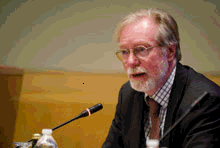LOW-INCOME COUNTRIES

Typical street scene in Santa Ana, El Salvador. (Photo: iStock)
IMF Survey: Sustainable Investment Holds Key to Growth in Low-Income Countries
December 7, 2010
- Public investment in low-income countries needs to be raised substantially
- Key goal is to build countries’ capacity to invest productively
- Low-income countries also need to build capacity to borrow safely
Low-income countries are poised for a takeoff in growth over the next decade, and strategic investment in infrastructure can be the driver if countries finance it in a sustainable way, said panelists at an IMF conference.

Worker in Chennai, India: Countries cannot rely solely on public sector financing, said India’s Gajendra Haldea at the conference (photo: Reuters/Babu)
“Sustainable Investment Scaling up in Low-Income Countries,” held November 30 at the IMF’s headquarters, brought together leading academics, researchers, private sector representatives, and policymakers to share their views on the challenges of infrastructure financing and debt management. The conference attracted a large audience, indicating the broad interest—inside and outside the IMF—in this topical issue.
The world economy presents a radically different picture than ever before, noted Min Zhu, Special Advisor to the IMF’s Managing Director, in opening the conference. For the first time, developing countries’ economic and financial situations look better than that of advanced economies, which are seeing high public sector debt, high unemployment rates, and relatively weak growth.
This more fragile outlook for advanced economies means they are less likely to provide the same level of external demand or financing for low-income countries in the foreseeable future, Zhu said. For low-income countries to sustain growth, they will thus need to unlock new sources of growth and investment financing.
“Investing in investing”
“In the next decade, low-income countries will have two big opportunities for financing major investment,” observed Oxford University’s Paul Collier, moderator of the first session. Harnessing revenues from natural resources, which are expected to increase over the next decade, is one; the second is borrowing, since many low-income countries are now in a position to take on more debt.

Low-income countries will have the opportunity to finance major investment, but they have to build the capacity to invest productively, said Paul Collier (photo: IMF).
What low-income countries lack, however, is the capacity to invest productively, Collier continued. “We have the task of what I call ‘investing in investing’—that is, building countries’ capacity for productive investment,” he said.
Jeffrey Sachs of Columbia University stressed the need to take a holistic view of the investment process and a country’s development more generally. Public sector investment, private sector investment, as well as government capacity to support investment are all essential, he said.
Sachs also called for a more significant role for multilateral development banks in the investment process. He proposed a special issue of long-term “infrastructure bonds” by regional development banks that could allow a “recycling” of some of China and Germany’s surplus savings. Regional development banks are well placed to help countries manage procurement, help with complex project financing, and oversee projects, he said, observing that this is the kind of “investment in investing” that would have an enormous return. Rather than exhorting China to consume more, the answer might be to invest China’s savings more effectively, he added.
Raising efficiency and borrowing safely
The consensus among participants was that low-income countries need to scale up infrastructure investment—but that how countries achieve this is a crucial determinant of success. Luis Serven of the World Bank noted that the amount spent is not a good indication of the quality or quantity of infrastructure built. Spending is often inefficient because of poorly selected projects, corruption, and waste. Moreover, the dearth of good data on spending—particularly for operation and maintenance of projects—is a big obstacle to understanding the costs of infrastructure, Serven said.
Participants discussed efforts by IMF and World Bank staff to develop tools to help build countries’ capacity to plan and assess investments and manage debt. Chris Papageorgiou of the IMF’s Strategy, Policy, and Review Department presented an index that he and others have created for assessing public investment management capacity in 71 countries. Andrew Berg of the IMF’s Research Department explained ongoing work on a model that helps assess the macroeconomic, growth and debt implications of an investment scaling up, depending on the efficiency of the investment and the various modes of financing.
Conor McCoole of Standard Chartered Bank offered a private sector viewpoint, discussing obstacles his company has faced in low-income countries. In Asia, where McCoole is based, the private sector wants to invest more in infrastructure, but faces a shortage of bankable opportunities. Countries need to reduce the legal complexity of doing business and establish a reasonable risk-reward balance for the private sector. Susan Lund of the McKinsey Global Institute echoed many of McCoole’s points, stressing that low-income country governments need to be realistic about what projects will attract private sector interest.
Matthew Martin of Debt Finance International stressed that a scaling up of public investment through borrowing raises the issue of whether the framework used to assess debt sustainability remains adequate. He suggested that much more attention needs be paid to total public debt, but also to the risk raised by some forms of private financing. François Painchaud of the IMF’s Strategy, Policy, and Review Department presented ongoing work to further improve the IMF-World Bank debt sustainability framework in light of these new challenges.
Sustaining an economic vision
In addition to a perspective from the G20, policymakers from middle- and low-income countries also shared their experiences. Public sector resources are only part of the picture, said Gajendra Haldea of India’s Planning Commission. “If you want to make a quantum jump, you’ve got to get other investment growth. Figure out, in your respective situations, the path that will take you to sustainable, market-based infrastructure development. That has been the focal point of our strategy—and so far, it seems to be working.”

”Infrastructure projects can work in a country with very low capacity only if you have good governance,” said Kampeta Sayingoza (photo: IMF)
Governance also plays a vital role, according to Kampeta Sayingoza of Rwanda’s Ministry of Finance and Economic Planning. “Infrastructure projects can work in a country with very low capacity only if you have good governance.” Rwanda, whose recent economic development has put it ahead of many other sub-Saharan African countries, also recognizes the importance of having an overarching investment strategy, she said.
“Investment is not a one-off check that you sign for a road. It is not just about building capital, it’s more about sustaining an economic vision,” Sayingoza said. “What I have found, in discussing with African colleagues, is that vision is what sometimes lacks.”







